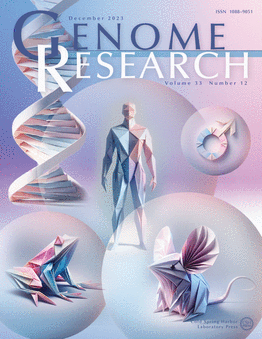Hierarchical architecture of neo-sex chromosomes and accelerated adaptive evolution in tortricid moths
IF 6.2
2区 生物学
Q1 BIOCHEMISTRY & MOLECULAR BIOLOGY
引用次数: 0
Abstract
Sex chromosomes can expand through fusion with autosomes, thereby acquiring unique evolutionary patterns. In butterflies and moths (Lepidoptera), these sex chromosome–autosome (SA) fusions occur relatively frequently, suggesting possible evolutionary advantages. Here, we investigated how SA fusion affects chromosome features and molecular evolution in leafroller moths (Lepidoptera: Tortricidae). Phylogenomic analysis showed that Tortricidae diverged ∼124 million years ago, accompanied by an SA fusion between the Merian elements M(20 + 17) and MZ. In contrast to partial autosomal fusions, the fused neo-Z Chromosome developed a hierarchical architecture, in which the three elements exhibit heterogeneous sequence features and evolutionary patterns. Specifically, the M17 part had a distinct base composition and chromatin domains. Unlike M20 and MZ, M17 was expressed at the same levels as autosomes in both sexes, compensating for the lost gene dosage in females. Concurrently, the SA fusion drove M17 as an evolutionary hotspot, accelerating the evolution of several genes related to ecological adaptation (e.g., ABCCs) and facilitating the divergence of closely related species, whereas the undercompensated M20 did not show such an effect. Thus, accelerated evolution under a novel pattern of dosage compensation may have favored the adaptive radiation of this group. This study demonstrates the association between a karyotype variant and adaptive evolution and explains the recurrent SA fusion in the Lepidoptera.圆蛾新性染色体的层次结构与加速适应进化
性染色体可以通过与常染色体融合而扩展,从而获得独特的进化模式。在蝴蝶和飞蛾(鳞翅目)中,这些性染色体-常染色体(SA)融合相对频繁地发生,表明可能具有进化优势。本文研究了SA融合对叶蛾染色体特征和分子进化的影响。系统基因组学分析表明,Tortricidae在大约1.24亿年前开始分化,并伴随着Merian元素M(20 + 17)和MZ之间的SA融合。与部分常染色体融合相比,融合的新z染色体形成了一个层次结构,其中三个元素表现出不同的序列特征和进化模式。具体来说,M17部分具有不同的碱基组成和染色质结构域。与M20和MZ不同,M17在两性中与常染色体的表达水平相同,弥补了雌性中丢失的基因剂量。同时,SA融合使M17成为进化热点,加速了与生态适应相关的几个基因(如abcc)的进化,促进了近亲物种的分化,而补偿不足的M20则没有表现出这种作用。因此,在一种新的剂量补偿模式下的加速进化可能有利于这一群体的适应性辐射。本研究证明了核型变异与适应性进化之间的联系,并解释了鳞翅目中反复发生的SA融合。
本文章由计算机程序翻译,如有差异,请以英文原文为准。
求助全文
约1分钟内获得全文
求助全文
来源期刊

Genome research
生物-生化与分子生物学
CiteScore
12.40
自引率
1.40%
发文量
140
审稿时长
6 months
期刊介绍:
Launched in 1995, Genome Research is an international, continuously published, peer-reviewed journal that focuses on research that provides novel insights into the genome biology of all organisms, including advances in genomic medicine.
Among the topics considered by the journal are genome structure and function, comparative genomics, molecular evolution, genome-scale quantitative and population genetics, proteomics, epigenomics, and systems biology. The journal also features exciting gene discoveries and reports of cutting-edge computational biology and high-throughput methodologies.
New data in these areas are published as research papers, or methods and resource reports that provide novel information on technologies or tools that will be of interest to a broad readership. Complete data sets are presented electronically on the journal''s web site where appropriate. The journal also provides Reviews, Perspectives, and Insight/Outlook articles, which present commentary on the latest advances published both here and elsewhere, placing such progress in its broader biological context.
 求助内容:
求助内容: 应助结果提醒方式:
应助结果提醒方式:


